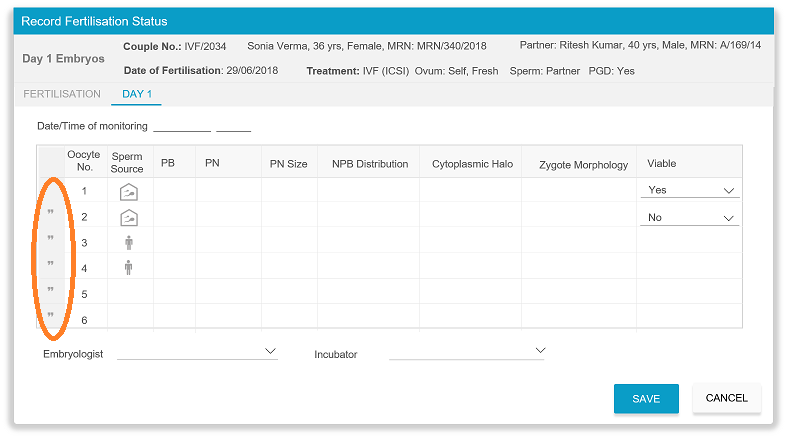Listening...to what the Users don't tell
Work done in 2018-19
Users don't always tell you what they need. You need to minutely observe the Users as they go about their tasks, observe their environment, their clumsiness. Then put it all together to design a Solution that will address their problems.
This is a compilation of some of the solutions done in the IVF module of medicseasy, a Hospital Information System from Ubq Technologies Pvt. Ltd. The images shared here are with prior permission from Ubq.
These screens were designed purely based on inputs put together after observing users.
Dittoing the user’s mental model
What you get out is proportional to what you put in. The more data one recorded in the IVF module, the more information and intelligence one could derive from it. We had to think of options to make data entry easy for these clinical users who were so hard pressed for time. We based our designs on two guidelines:
1) Provide default values as far as possible – These defaults could be based on a specific context like drug dosages in a pre-defined Treatment plan or on other context such as a user
2) Provide mechanisms to copy related data - When we studied the filled paper forms that the clinicians used, we observed that in tabular data, they would put a ‘ditto’ (“) where the values matched the row immediately above. The forms would have more dittos than values. We gave them the same facility in the screens. This would not only help expedite data entry, but was also a perfect fit to their mental model.

The Whiteboards
The Embryologists are a busy lot, with their tasks cut out for the day. There is zero-tolerance when it comes to completing tasks on time. Missing a day in the growth of an embryo could ultimately lead to abandoning of the Patient’s cycle. In the Embryology lab, we noticed that a whiteboard was being regularly updated every few hours. A deeper study of this activity revealed that the technicians were updating the status of the current day’s tasks. Towards the end of the day, the next day’s tasks would be listed. This way, the Senior Embryologist would get to monitor the recent status and take steps to ensure that no task was missed. The Technicians would get to plan for the next day’s tasks.
The Dashboard shown here was our version of the whiteboard, with additional features. As each technician completed her task, the Dashboard would reflect the status visually. Apart from the task status, it would alert about delayed tasks or tasks that could potentially be delayed.

Saving the users from Information fatigue
If you ask the users whether they wish to see a particular piece of information on a given screen, the answer will always be in the affirmative. That’s because users don’t know. As the quantum of data being recorded goes up, so also does the challenge of displaying just the right data at the right time to the users. Progressive Disclosure of Information is vital while designing the screens. This reduces the cognitive load on the users and expedites the absorbing of information for the user.
This screen seen by Doctors is an example of this principle. The Active IVF Treatment Cycle is shown in this screen as part of the Patients EMR. While The Embryologist is responsible for recording the information of Embryo growth, the Doctor’s interest is in knowing whether Embryos are viable for a transfer. So here, we show information of Embryos in 3 levels:
1) A summary upfront about the count and status of Embryos - This is displayed at the top of the section in a bigger font and will typically be what the Doctor reads first on coming to this screen
2) More detail with the Growth chart of the Embryos - This is a cross-tab view across days for the Embryos. While many parameters are recorded on each day, we show just the key parameters on each day. The Embryos are cultured over a maximum of 6 days. This is displayed just below the summary and intentionally not hidden behind another button click, since most of the times the Doctor would want to know further details about each Embryo.
3) Further details about the Day-wise growth – This is not shown initially. Only if the Doctor wishes to drill further, she can click a button to see every detail recorded about the Embryos


